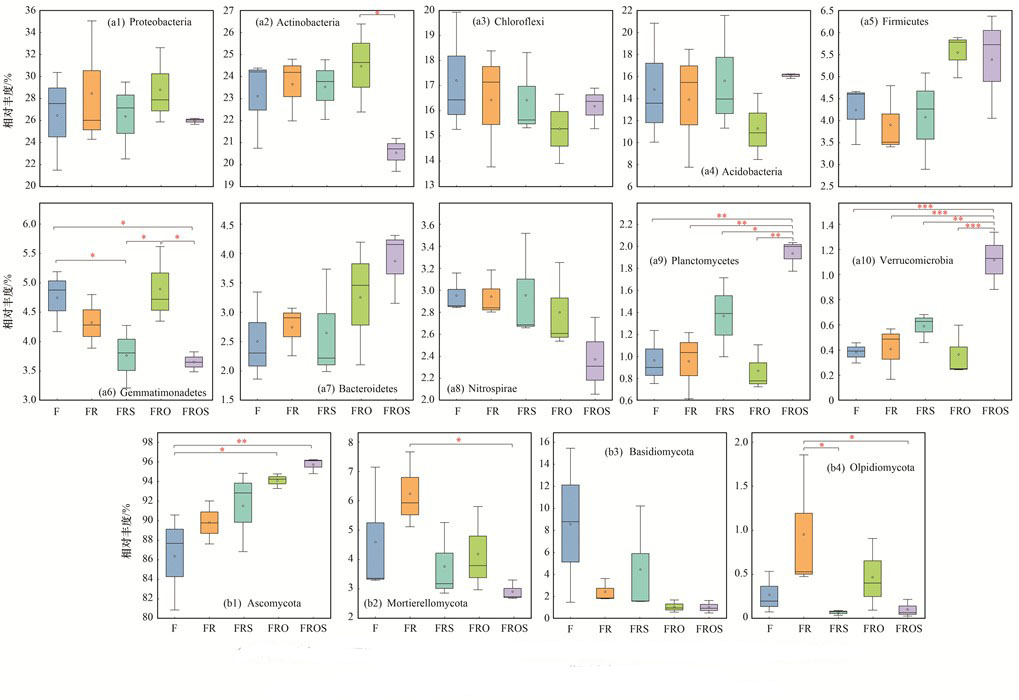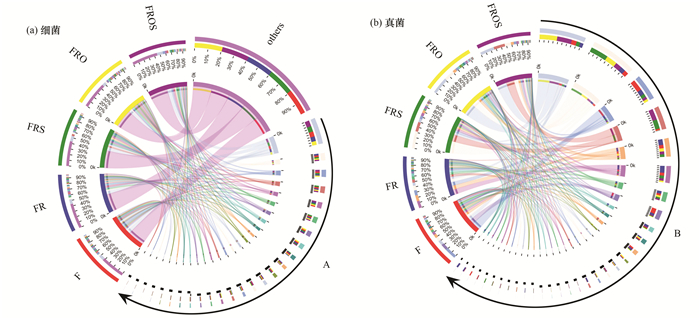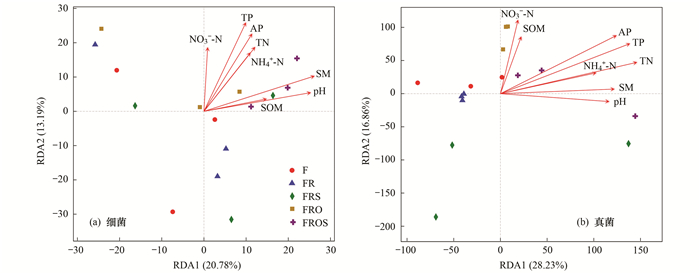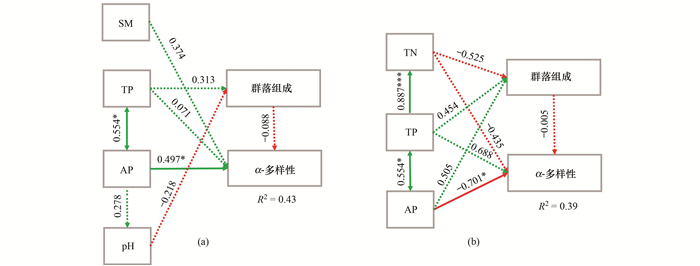土壤微生物在维持土壤健康、生产力和可持续性等方面发挥着重要作用[1].土壤微生物主要由细菌和真菌组成, 二者共同维持土壤环境健康[2].细菌能够促进土壤结构改善和植物生长[3], 真菌可以与农作物共生形成菌根, 进而促进植物生长和维持农业生态系统稳定[4].细菌和真菌群落各自内部及二者之间的相互作用对于生态系统服务功能的提高具有重要意义, 复杂的微生物网络有助于提高生态系统功能多样性[5].近年来, 专家学者重点关注细菌群落对施肥方式的响应特征, 而对真菌群落及其与细菌群落之间的内在联系有待进一步探索[6].
面对日益增长的粮食需求, 为获得更高的作物产量, 化肥投入量往往大于作物对养分的需求[7].化肥施用量超过一定阈值不仅不能促进作物的增产, 反而会造成大量的元素损失[8], 降低土壤微生物多样性进而增加土壤退化风险[9].不同施肥措施会引发土壤理化性质变化, 进而导致土壤微生物群落结构发生改变.研究表明, 长期施用无机肥会降低细菌和真菌的多样性和数量, 改变群落组成[10, 11].越来越多的研究证实, 有机肥部分替代化肥已成为实现粮食增产、遏制环境污染的有效措施[12, 13].有机肥可以通过改善土壤理化性质和调节土壤酶活性来降低氮肥氨挥发, 减少磷钾肥在土壤中的固定以提高供肥能力[14].实施有机培肥措施是恢复土壤肥力并提高土壤生产力的重要农耕举措[15].有机肥对土壤有机质的积累以及微生物群落组成和相互关系的改善起着至关重要的作用[16].
在华北平原等农业集约化地区, 化肥的过量施用是农业发展面临的一大难题[8].冬小麦-夏玉米轮作制是华北地区典型的农业耕作制度[9], 其小麦和玉米产量分别占全国总产量的60%~80%和35%~40%[17].因富含有机碳和植物生长所必需的氮磷钾以及其它微量元素, 作物收获后残留的副产物——秸秆作为一种生物质资源可用作特殊有机肥料.作物秸秆回田利用不仅可以节约化肥, 还能增加土壤有机碳的含量, 减轻秸秆焚烧带来的大气污染[18].据报道, 秸秆添加可以改善土壤结构, 保持土质疏松多孔, 并通过改变土壤的理化性质直接或间接地影响土壤微生物群落[7].例如, 秸秆还田提高了拟杆菌门(Bacteroidetes)和变形菌门(γ- Proteobacteria)的相对丰度[19], 增加了真菌的丰富度和多样性[20].
在可持续农业发展的背景下, 了解细菌和真菌群落如何响应现代农业施肥制度非常重要[21].现有的研究主要集中在有机-无机肥配施或秸秆还田等施肥方式导致的土壤微生物群落变化, 而化肥-有机肥-秸秆三者结合的施肥方式下土壤细菌和真菌群落的响应机制及主要驱动因子尚缺乏深入研究, 尤其是对华北平原潮土区典型麦玉轮作田化肥减量并配施有机肥和秸秆后土壤微生物群落多样性及其结构变化的研究鲜有报道.此外, 细菌和真菌群落对不同施肥方式的响应不尽相同.有研究表明, 有机肥和秸秆的施入改变了真菌群落结构和多样性, 但对细菌群落结构和多样性的影响并不显著[22, 23], 但有学者持不同观点[24].因此, 为进一步探明土壤细菌和真菌群落对潮土减量化肥-有机肥-秸秆三者结合的施肥方式的响应机制, 本研究采用高通量测序技术并结合生物信息学分析明确不同施肥措施对农田潮土细菌及真菌的物种组成、多样性和群落结构的影响, 明晰引起细菌和真菌群落变化的主控土壤环境因子, 以期为华北潮土区农田合理施肥提供科学依据.
1 材料与方法 1.1 试验地概况与试验设计本试验地位于天津市宁河区试验基地(39°48′N, 117°71′E), 土壤类型为潮土.该地区属温带大陆性季风气候, 年均气温11.2℃, 年均降水量642 mm, 全年无霜期210 d[25].本试验始于2015年, 耕作方式为冬小麦-夏玉米轮作, 田间管理按照当地常规生产模式进行.试验共设5个处理:单施化肥处理(F)、化肥减量处理(FR)、化肥减量与秸秆配施处理(FRS)、化肥减量与有机肥配施处理(FRO)和化肥减量与有机肥和秸秆配施处理(FROS), 试验小区具体施肥情况见表 1.由于各处理小区面积较大(22 m×22 m), 故没有设置重复小区, 取样时将小区分为3个区域即3次假重复.
|
|
表 1 试验小区施肥情况 Table 1 Fertilization situation in test plots |
本试验中施用的肥料包括无机复合肥(N含量28%, P2O5含量13%, K2O含量5%)、磷肥(P2O5含量12%)、钾肥(K2O含量60%)、尿素(N含量46%)以及有机肥(NPK总含量≥5%, 有机质含量≥40%), 由石家庄市希星肥业科技有限公司生产.每年9月底玉米收获后, 将有机肥、磷肥、钾肥和纯氮量60%的化肥(无机复合肥)作为基肥在冬小麦播种时一次性施入农田.6月初小麦收获后, 在玉米播种时将磷肥、钾肥和纯氮量60%的化肥(无机复合肥)作为基肥一次性施入农田.在小麦苗期和玉米拔节期分别追施纯氮量40%的化肥(尿素).小麦秸秆全部粉碎后覆盖地表还田, 玉米秸秆粉碎成小段翻埋还田.
1.2 土壤样品采集2019年9月于玉米收获前, 使用直径5 cm的土壤采样器采集0~20 cm耕层土壤, 将在每个区域随机采集的5个土芯混合成1个土壤样品, 剔除石砾和植物残体等杂质后装入灭菌自封袋暂存于保温箱中并迅速带回实验室.将每份土壤样品过2 mm筛后分为3份子样品, 一份于-70℃保存, 用于土壤DNA提取; 另一份经风干或烘干后用于测定土壤理化性质; 第三份于4℃保存, 用于测定土壤铵态氮(ammonium nitrogen, NH4+-N)和硝态氮(nitrate nitrogen, NO3--N)含量.
1.3 试验方法 1.3.1 土壤理化性质测定土壤化学性质的测定方法参照文献[26].土壤pH在2.5:1水土比下采用复合电极测定; SOM采用重铬酸钾容量法测定; TN采用半微量开氏法测定; TP采用HClO4-H2SO4消煮-钼锑抗比色法测定; AP采用NaHCO3浸提-钼锑抗比色法测定; NO3--N和NH4+-N经0.01 mol·L-1 CaCl2浸提后使用流动分析仪(AA3, SEAL Analytical, Germany)测定; 将土壤样品于105℃下烘干8 h至恒重, 测定土壤含水量(soil moisture, SM).
1.3.2 土壤DNA提取和PCR扩增采用Fast DNA® Spin Kit for Soil (MP Biomedicals, U.S.A)按照说明书进行土壤DNA抽提, 使用1%的琼脂糖凝胶电泳检测DNA的提取质量, 使用NanoDrop2000测定DNA浓度和纯度.用引物338F(5′-ACTCCTACGGGAGGCAGCAG-3′)和806R(5′-GGACTACHVGGGTWTCTAAT-3′)扩增细菌16S rRNA基因的V3-V4高变区序列[27], PCR扩增程序如下:95℃预变性3 min, 27个循环(95℃变性30 s, 55℃退火30 s, 72℃延伸45 s), 然后72℃稳定延伸10 min.用引物ITS1F(5′-CTTGGT CATTTAGAGGAAGTAA-3′)和ITS2R(5′-GCTG CGTTCTTCATCGATGC-3′)扩增真菌的ITS rRNA区序列[28], PCR扩增程序如下:95℃预变性3 min, 35个循环(95℃变性30 s, 55℃退火30 s, 72℃延伸45 s), 然后72℃稳定延伸10 min. PCR反应体系为:5×TransStart FastPfu缓冲液4 μL, 2.5 mmol·L-1 dNTPs 2 μL, 上下游引物(5 μmol·L-1)各0.8 μL, TransStart FastPfu DNA聚合酶1.0 U, 模板DNA 10 ng, 加ddH2O补足至20 μL.本试验中设置空白对照, 空白对照和每个DNA样品均设置3次重复.
1.3.3 Illumina高通量测序与生物信息学分析将同一样品的PCR产物混合后通过2%琼脂糖凝胶电泳, 使用AxyPrep DNA Gel Extraction Kit(Axygen Biosciences, Union City, CA, USA)进行回收纯化, 回收产物经2%琼脂糖凝胶电泳检测并用QuantusTM Fluorometer(Promega, USA)进行定量.使用NEXTFLEX® Rapid DNA-Seq Kit进行建库:①接头链接; ②使用磁珠筛选去除接头自连片段; ③利用PCR扩增进行文库模板的富集; ④磁珠回收PCR产物得到最终的文库.利用Illumina公司的MiSeq PE300平台进行测序.使用Trimmomatic软件对原始测序序列进行质控, 使用FLASH软件进行拼接:①过滤序列尾部质量值20以下的碱基, 设置50 bp的窗口, 如果窗口内的平均质量值低于20, 从窗口开始截去后端碱基, 过滤质控后50 bp以下的序列, 去除含N碱基的序列; ②根据PE序列之间的重叠关系, 将成对序列拼接成一条序列, 最小重叠长度为10 bp; ③拼接序列的重叠区允许的最大错配比率为0.2, 筛选不符合序列; ④根据序列首尾两端的条形码和引物区分样品, 并调整序列方向, 条形码允许的错配数为0, 最大引物错配数为2.使用UPARSE软件(version7.1, http://drive5.com/uparse/), 根据97%的相似度对高质量的核酸序列聚类到操作分类单元(operational taxonomic units, OTUs)并剔除嵌合体[29].利用RDP classifier(http://rdp.cme.msu.edu/)对每条序列进行物种分类注释, 设置比对阈值为70%.使用QIIME程序计算群落Shannon多样性指数和Chao1丰富度指数.
1.3.4 统计分析利用单因素方差分析(One-way ANOVA)中的Duncan方法对不同处理的土壤理化性质和物种组成的相对丰度进行方差分析和显著性检验.使用SPSS 23.0进行皮尔逊(Pearson)相关分析.采用基于Bray-Curtis距离矩阵的非度量多维尺度分析(non-metric multidimensional scaling, NMDS)确定细菌和真菌群落的结构差异.采用R语言vegan包进行相似性分析(analysis of similarities, ANOSIM)以确定组间差异是否显著大于组内差异, 并进行冗余分析(redundancy analysis, RDA)以评价土壤环境因子对细菌和真菌群落结构的影响.采用AMOS软件(IBM SPSS AMOS 21.0.0)构建结构方程模型(structural equation model, SEM)框架检测土壤环境因子、群落组成和群落多样性间假设因果关系的显著性.
2 结果与分析 2.1 土壤理化性质变化不同施肥处理改变了土壤SOM、TP、AP和NH4+-N含量(表 2).与F和FR处理相比, 添加有机肥(FRO)显著提高了土壤SOM含量, 土壤SOM含量分别增加了21.30%和20.10%. FROS处理的土壤TP含量显著高于FRS处理, 达到13.33%.施入有机肥和秸秆处理(FRO和FROS)后土壤AP含量显著增加, 相比于其它处理分别提高了18.03%~33.45%和22.69%~38.72%. FRO和FROS处理的NH4+-N含量显著高于化肥处理(F和FR), 分别是F处理的2.14和2.23倍, 是FR处理的2.23和2.33倍.各处理间土壤pH、TN、NO3--N和SM值无显著差异.
|
|
表 2 不同施肥处理土壤理化性质1) Table 2 Physicochemical properties of soil under different fertilization treatments |
2.2 细菌和真菌群落组成的变化
经过质量筛选后, 共获得864 358条(每个样品40 790~70 539条序列)高质量的16S rRNA基因序列和1 009 448条(每个样品52 235~74 038条序列)高质量的ITS序列.基于97%的相似性阈值进行聚类, 分别得到5 905个和746个OTU.
聚类分析结果表明, 细菌菌群分属46个门、118个纲、242个目、457个科、887个属和1791个种, 真菌菌群分属9个门、27个纲、67个目、140个科、242个属和383个种.细菌和真菌群落在门水平上的物种组成如图 1所示.各处理中土壤优势细菌门(相对丰度大于10%)为变形菌门(Proteobacteria, 平均相对丰度为27.22%)、放线菌门(Actinobacteria, 23.06%)、绿弯菌门(Chloroflexi, 16.30%)和酸杆菌门(Acidobacteria, 14.34%), 这4个门占总序列数的80.93%, 其次为厚壁菌门(Firmicutes, 4.63%)、芽单胞菌门(Gemmatimonadetes, 4.27%)、拟杆菌门(Bacteroidetes, 3.00%)、硝化螺旋菌门(Nitrospirae, 2.80%)、浮霉菌门(Planctomycetes, 1.22%)和疣微菌门(Verrucomicrobia, 0.57%).子囊菌门(Ascomycota)是各处理土壤的优势真菌门, 平均相对丰度为91.50%, 其次为被孢菌门(Mortierellomycota, 4.34%)、担子菌门(Basidiomycota, 3.51%)和油壶菌门(Olpidiomycota, 0.37%).

|
(a)细菌群落组成;(b)真菌群落组成;将所有样本中相对丰度均小于1%的物种归为others,下同 图 1 土壤细菌和真菌群落组成 Fig. 1 Community composition of soil bacteria and fungi |
不同施肥处理下细菌和真菌的相对丰度变化见图 2.在化肥减量并配施有机肥(FRO)的基础上, 秸秆的添加(FROS)显著降低了放线菌门(Actinobacteria)的相对丰度, 降低幅度达到16.06%.与F和FRO处理相比, 秸秆的添加(FRS和FROS)同样显著降低了芽单胞菌门(Gemmatimonadetes)的相对丰度, 变化幅度在20.84%至25.36%之间(FRO).与之相反, FROS处理显著提高了浮霉菌门(Planctomycetes)和疣微菌门(Verrucomicrobia)的相对丰度, 分别增加了41.61%~122.99%和89.83%~211.11%. Pearson相关分析表明(表 3), 土壤AP含量与厚壁菌门(Firmicutes)的相对丰度极显著正相关(P < 0.01), 而土壤TN含量与硝化螺旋菌门(Nitrospirae)的相对丰度显著负相关(P < 0.05).土壤TN、TP、AP和NH4+-N是影响拟杆菌门(Bacteroidetes)的关键因素.土壤SM与浮霉菌门(Planctomycetes)和疣微菌门(Verrucomicrobia)的相对丰度显著正相关(P < 0.05).就真菌群落而言, 有机肥和秸秆(FRO和FROS)的施入显著提高了子囊菌门(Ascomycota)的相对丰度, 分别达到8.94%和10.81%.而与FR处理相比, 有机肥和秸秆的配合施用(FROS)显著降低了被孢菌门(Mortierellomycota)和油壶菌门(Olpidiomycota)的相对丰度, 下降幅度分别达到53.45%和89.47%, 且FRS处理的油壶菌门(Olpidiomycota)的相对丰度同样下降显著, 达到92.63%.土壤AP(P < 0.05)和NH4+-N(P < 0.01)促进了子囊菌门相对丰度的显著增加, 而其它土壤化学指标则没有表现出显著关系(表 3).

|
(a)细菌相对丰度;(b)真菌相对丰度;***表示在0.001水平上显著相关,**表示在0.01水平上显著相关,*表示在0.05水平上显著相关 图 2 土壤细菌和真菌的主要菌门(相对丰度>1%)丰度变化 Fig. 2 Abundance of dominant bacteria(relative abundance>1%)in soil bacteria and fungi |
|
|
表 3 细菌和真菌主要菌门与土壤理化性质之间的Pearson相关性1) Table 3 Pearson correlation between bacterial and fungal dominant phyla and soil physicochemical properties |
细菌和真菌群落在属水平上的物种组成如图 3所示.结果表明, 整体上各处理真菌群落物种组成差异较细菌更为明显.其中, unclassified_f_ Chaetomiaceae属在有机肥处理(FRO和FROS)中的比例高于其它处理, 篮状菌属(Talaromyces)在FRS处理中的占比最高, 光黑壳属(Preussia)广泛存在于秸秆处理(FRS和FROS), 而假单胞菌属(Pseudeurotium)则在化肥处理(F和FR)中含量较高.

|
A中表示(从上往下)norank_c__Acidobacteria norank_o__JG30-KF-CM45 norank_ f__Anaerolineaceae norank_c__Actinobacteria Pseudarthrobacter Nitrospira norank_ f__MSB-1E8 norank_ f__Gemmatimonadaceae norank_c__KD4-96 norank_ f__Nitrosomonadaceae Bacillus H16 RB41 norank_ f__OM1_clade Gaiella norank_o__Acidimicrobiales norank_c__S085 norank_c__Gemmatimonadetes Roseiflexus norank_ f__Rhodospirillaceae Sphingomonas norank_o__Gaiellales norank_o__Xanthomonadales norank_c__TK10 Skermanella unclassified_ f__Nocardioidaceae
B中表示(从上往下)unclassified_ f__Chaetomiaceae Talaromyces Pseudeurotium Preussia others unclassified_ f__Lasiosphaeriaceae Mortierella unclassified_c__Sordariomycetes Fusarium unclassified_o__Pleosporales Nectria Dokmaia Penicillium unclassified_p__Ascomycota Chaetomium Metarhizium unclassified_ f__Coniochaetaceae unclassified_o__Hypocreales Cladosporium Fusicolla Waitea Trichoderma Alternaria Acremonium Clonostachys Aspergillus unclassified_ f__Nectriaceae Saitozyma Guehomyces unclassified_c__Agaricomycetes Plectosphaerella unclassified_ f__Halosphaeriaceae 图 3 土壤细菌和真菌的主要菌属(相对丰度>1%)在各处理中的百分比 Fig. 3 Percentage of dominant genera (relative abundance>1%) of soil bacteria and fungi in each treatment |
如图 4所示, FROS处理的细菌群落的Shannon多样性指数较F和FR处理显著升高, 分别达到1.26%和1.25%(P < 0.01), Chao1指数较F处理显著提高4.51%, 而与FR处理相比, 配施有机肥和添加秸秆的3个处理(FRS、FRO和FROS)显著降低了真菌群落的Shannon多样性指数, 分别下降了29.85%、24.94%和25.73%(P < 0.05). Pearson相关性表明(表 4), 细菌Shannon多样性指数与土壤AP和NH4+-N含量显著正相关(P < 0.05), 而真菌Shannon多样性指数与土壤AP含量显著负相关(P < 0.05).

|
(a)和(c)细菌α-多样性指数; (b)和(d)真菌α-多样性指数; **表示在0.01水平上显著相关, *表示在0.05水平上显著相关 图 4 土壤细菌和真菌群落Shannon指数和Chao1指数 Fig. 4 Shannon index and Chao1 index of soil bacterial and fungal communities |
|
|
表 4 细菌和真菌Shannon指数和Chao1指数与土壤理化性质之间的Pearson相关性1) Table 4 Pearson correlation between Shannon index and Chao1 index of bacteria and fungi and soil physicochemical properties |
采用NMDS分析并结合ANOSIM分析揭示细菌和真菌群落β-多样性(图 5).结果表明, 与F处理相比, FR、FRS和FRO处理下细菌群落组成有一定的迁移. FROS处理显著不同于F、FR和FRO处理.细菌群落结构在F、FR、FRS和FRO处理之间无显著差异(R2=0.031 5, P=0.892).与细菌群落不同, FR和F处理之间真菌群落组成发生重合, FRO和FROS处理显著不同于F和FR处理.与FRS处理相比, FROS处理下真菌群落组成有一定的迁移, 且FRO处理显著不同于FRS处理.真菌群落结构在FR、FRO和FROS这3个处理之间显著区分(R2=0.579 6, P=0.001).

|
图 5 土壤细菌和真菌群落NMDS分析 Fig. 5 NMDS analysis of soil bacterial and fungal communities |
细菌和真菌群落结构与土壤理化性质的RDA分析结果表明, Axis1和Axis2分别可以解释土壤细菌群落变异的20.78%和13.19%, 土壤真菌群落变异的28.23%和16.86%, 前两轴共解释了33.97%的细菌群落总变异和45.09%真菌群落总变异(图 6). Mantel检验结果表明, SM (R2=0.554 5, P=0.008), TP (R2=0.501 9, P=0.02), pH (R2=0.446 9, P=0.03)和AP (R2=0.432 1, P=0.036)是影响细菌群落结构的主要土壤环境因子; TN (R2=0.511 7, P=0.014)、AP (R2=0.470 7, P=0.017)和TP (R2=0.520 3, P=0.02)是影响真菌群落结构的关键土壤环境因子.

|
图 6 土壤细菌和真菌群落的RDA分析 Fig. 6 RDA analysis of soil bacterial and fungal communities |
将经RDA筛选出的具有显著性的土壤环境因子构建结构方程模型(SEM)(图 7).SEM解释了细菌群落α-多样性的43%, 真菌群落α-多样性的39%.结果表明, TP与AP呈显著正相关(P < 0.05), TP极显著正向影响TN(P < 0.001).AP对细菌群落的α-多样性具有显著的积极作用(P < 0.05), 而对真菌群落的α-多样性产生了显著的负面影响(P < 0.05).

|
(a)细菌群落(χ2=4.999, P=0.660, GFI=0.906, AIC=32.999, RMSEA=0.000); (b)真菌群落(χ2=0.344, P=0.558, GFI=0.990, AIC=28.344, RMSEA=0.000);图中绿线代表正相关, 红线代表负相关, 实线代表相关性显著, 虚线代表相关性不显著; ***表示在0.001水平上显著相关, *表示在0.05水平上显著相关 图 7 土壤理化因子和群落组成对细菌群落和真菌群落α-多样性的结构方程模型 Fig. 7 Structural equation model of soil physicochemical factors and community composition on α-diversity of bacterial community and fungal community |
本研究中各处理间土壤pH值没有发生显著变化, 但整体上有上升趋势(表 2), 这可能是秸秆分解和有机肥料添加抑制土壤酸化并逐渐提高土壤pH的结果[30].在化肥减量的基础上, 有机肥和秸秆的添加提高了土壤SOM含量, 其中在FRO处理下达到显著水平(P < 0.05, 表 2), 这一结果与Li等[17]的报道相一致.有机肥和秸秆是提高有机碳含量的重要来源, 外源碳输入可以通过刺激微生物矿化、固定化和土壤呼吸的过程来影响土壤SOM含量[7, 31].本研究显示有机肥施入显著提高了土壤AP含量(表 2), 推测有机肥施入土壤后, SOM的增加会导致有机酸的产生, 从而活化土壤中的P元素, 并向土壤提供大量阴离子, 与铁和铝等金属阳离子形成稳定的螯合物, 从而减少无机P的固定, 提高P元素的有效性[32].施入SOM后, 会增加土壤有机P的含量, 因为编码碱性磷酸单酯酶基因的微生物数量增加, 土壤碱性磷酸酶活性增强, 会矿化有机磷生成无机P, 这也可能是AP含量升高的原因[33].但是, 单独秸秆还田(FRS)并没有使土壤AP含量显著提高, 这与Zhao等[34]的研究相一致.土壤脲酶可以有效提高土壤NH4+-N含量, 在先前的报道中, 添加有机肥和秸秆可以显著提高土壤脲酶活性[35, 36], 这可能是本研究中土壤NH4+-N含量呈现上升趋势的原因(表 2).
3.2 不同施肥处理对细菌和真菌群落组成的影响各施肥处理中变形菌门(Proteobacteria)、放线菌门(Actinobacteria)、绿弯菌门(Chloroflexi)和酸杆菌门(Acidobacteria)是细菌群落的优势菌门(图 1), 这与以往学者的研究结果一致[24, 37].放线菌门(Actinobacteria)、厚壁菌门(Firmicutes)和浮霉菌门(Planctomycetes)作为富营养菌对土壤碳氮循环发挥着重要作用.本研究中添加秸秆显著降低了芽单胞菌门(Gemmatimonadetes)的相对丰度(图 2), 这与先前的报道不同[38].细菌在秸秆降解初期起主要作用[39], 而本研究取样时间在收获期, 秸秆降解后期真菌起主要作用[39], 真菌与细菌产生竞争关系可能使得以秸秆为碳源和能源的芽单胞菌门(Gemmatimonadetes)数量下降.有机肥和秸秆部分替代化肥显著提高了浮霉菌门(Planctomycetes)的相对丰度(图 2), 这与荣勤雷[40]的研究结果一致.Tveit等[41]的研究表明, 疣微菌门(Verrucomicrobia)具有编码参与作物残茬降解酶的基因, 这与本研究中疣微菌门(Verrucomicrobia)的相对丰度在有机肥和秸秆的配施下极显著提高所对应(图 2).而在同一处理下, 放线菌门(Actinobacteria)的相对丰度相比有机-无机配施处理(FRO)有所下降(图 2), 这可能与土壤团聚体的大小有关.有研究表明, 随着土壤团聚体粒径的增加, 放线菌门(Actinobacteria)的相对丰度降低, 而硝化螺旋菌门(Nitrospirae)的相对丰度增加[40].有机物料在微生物的分解下为团聚体的形成提供了有机无机胶结物质, 促进了土壤大团聚体的形成进而降低了放线菌门(Actinobacteria)的相对丰度, 而长期施氮可能会破坏土壤团聚体的稳定性, 这与本研究中硝化螺旋菌门(Nitrospirae)的相对丰度与土壤TN含量呈显著负相关的结果相对应(表 3). Zhao等[3]也获得了相同的研究结果.与其它优势菌门不同, 拟杆菌门(Bacteroidetes)与TN、TP、AP和NH4+-N等多种土壤环境因子呈极显著或显著正相关(表 3), 充分说明拟杆菌门(Bacteroidetes)对有机物的降解发挥积极作用, 更适合生存于土壤养分含量相对较为丰富的土壤[40, 42].
子囊菌门(Ascomycota)是本研究中真菌群落的优势菌门(图 1), 这与前人的研究一致[12, 43].子囊菌门(Ascomycota)作为一种适宜在干旱环境中生存的腐生真菌, 受秸秆的强烈影响[44].在本研究中, 在化肥减量的基础上, 有机肥和秸秆的配施显著提高了子囊菌门(Ascomycota)的相对丰度(图 2), 这归因于子囊菌门(Ascomycota)具有降解腐烂有机底物的能力, 是土壤有机物(纤维素、木质素和果胶)的主要分解者, 易受植物种类和秸秆残茬的影响[45].粪壳菌目(Sordariales)和盘菌目(Pezizales)隶属于子囊菌门(Ascomycota), 适宜在含有有机化合物的栖息地生存, 在有机残留物的降解中发挥着重要作用[16].相关性分析表明, 子囊菌门(Ascomycota)的相对丰度与AP含量呈显著正相关(表 3), 这与王小玲等[46]的研究结果相一致.从属水平上看, 有机物料的添加提高了unclassified_ f_ Chaetomiaceae属、篮状菌属(Talaromyces)和光黑壳属(Preussia)的比例, 抑制了假单胞菌属(Pseudeurotium)的生长(图 3).毛壳菌科(Chaetomiaceae)可以产生纤维素酶、木聚糖酶和漆酶等降解纤维素和木质素[47], 篮状菌属(Talaromyces)具有产纤维素酶活性[48], 光黑壳属(Preussia)可能在降解秸秆中大分子物质上发挥积极作用, 而假单胞菌属(Pseudeurotium)中的部分菌株为致病菌, 威胁动植物生长和人类健康[49].
3.3 不同施肥处理对细菌和真菌群落多样性的影响在化肥减量的基础上, 有机肥和秸秆的配施显著提高了细菌Shannon多样性指数和Chao1指数(图 4), 这与前人的报道一致[29].不利的土壤环境条件会加剧微生物群落之间的竞争与合作, 而有机物料的施入为这些以异养方式生存的细菌提供了大量的养分来源, 从而减轻细菌群落之间的竞争[16].与细菌群落不同, 有机肥和秸秆的添加显著降低了真菌Shannon多样性指数(图 4), 这与Wang[29]的报道结果一致.这可能是由于有机物料的施入使得某些特定真菌类群产生“偏爱”效应, 消耗大量营养物质, 从而抑制了其它类群的生长[50], 长期施用有机物料利于驱使土壤由“真菌型”向“细菌型”转变[51].真菌适宜在pH <5的酸性土壤中, 弱碱性环境并不利于真菌的生长[52], 而有机肥和秸秆配施后pH的升高更利于细菌的生长[38].相关性分析表明AP含量增加导致子囊菌门(Ascomycota)相对丰度增加(表 3), 真菌种类趋于更加集中, Shannon多样性指数降低(表 4), 可以推测, 有机物料的添加可能刺激了子囊菌门(Ascomycota)类群的大量生长.
Suzuki等[53]的研究认为真菌群落较细菌群落对无机肥和有机肥的响应更为敏感, 而相比施肥制度, 细菌群落的生长与土壤类型更为密切.NMDS分析说明了潮土细菌和真菌均对化肥-有机肥-秸秆三者配施具有较强响应, 同时真菌对有机-无机配施同样敏感, 细菌却不是这样(图 5).王慧颖等[51]报道了黑土细菌群落对有机肥的强烈响应, 其结果与本研究中的潮土细菌群落并不完全一致, 其原因可能受土壤类型和气候条件的影响不同.细菌群落组成在化肥减施、化肥-秸秆和化肥-有机肥这3个处理下有一定的迁移, 可能与不同施肥方式下土壤性质变化有关[38].
3.4 细菌和真菌群落结构的影响因子分析土壤作为微生物的重要栖息地, 一方面可以直接为微生物提供生存所必需的环境条件, 另一方面可以通过影响植物根系分泌物来间接影响微生物群落结构[52].有研究表明, 土壤细菌群落组成主要取决于土壤性质, 且pH是影响重建新细菌群落的主导因子[54].通过RDA分析发现, 不同施肥处理下土壤细菌群落与SM、TP、pH和AP均有显著的相关关系(P < 0.05, 图 6), 虽然各处理间pH值的变化范围很小(8.11~8.22), 但已成为影响细菌群落结构的主要驱动因子之一.华北平原耕地大多为旱地, 土壤水分含量较低限制了土壤养分的矿化[37], 制约着细菌的生长.本研究中TN为真菌群落的主要驱动因子(图 6), 这与季凌飞等[55]的研究结果相似.AP对细菌和真菌群落α-多样性的作用显著却相反, 这可能是因为细菌生长需P, AP对细菌有促进作用, 而真菌主要与植物共生并为植物供P, 从而可能导致供P真菌的比例减少, 表现出负相关, 这在农业施肥管理中应引起充分重视.人们普遍认为肥料的类型与施用量是影响微生物群落结构的重要因素, 而本研究中土壤细菌和真菌群落的前两轴仅解释了样本33.97%和45.09%的总变异(图 6), SEM进一步解释了细菌群落α-多样性的43%, 真菌群落α-多样性的39%.说明施肥措施对细菌和真菌群落结构的影响并非唯一或首位要素, 下一步应更全面地分析群落结构变化的影响因素.
4 结论本研究采用高通量测序技术揭示了不同施肥处理下潮土细菌和真菌群落结构特征.结果表明, 变形菌门(Proteobacteria)、放线菌门(Actinobacteria)、绿弯菌门(Chloroflexi)和酸杆菌门(Acidobacteria)是潮土主要细菌类群, 子囊菌门(Ascomycota)是潮土主要真菌类群.化肥减量配施有机肥和秸秆可显著提高细菌群落的多样性, 但在化肥减量的基础上配施有机肥或(和)秸秆显著降低了真菌群落的多样性.潮土细菌群落结构受SM、TP、pH和AP的综合影响; 潮土真菌群落结构受TN、AP和TP的综合影响.潮土细菌和真菌均对化肥减量配施有机肥和秸秆有较强的响应, 同时有机无机配施也显著影响真菌群落结构.添加有机肥和秸秆改变了土壤理化性质, 进而改变了土壤细菌和真菌群落组成, 土壤真菌对有机物料的敏感程度高于细菌, 细菌和真菌群落结构均受到土壤P的调控, 在潮土农业耕作中应引起充分重视.
| [1] | Pan H, Chen M M, Feng H J, et al. Organic and inorganic fertilizers respectively drive bacterial and fungal community compositions in a fluvo-aquic soil in northern China[J]. Soil and Tillage Research, 2020, 198: 104540. DOI:10.1016/j.still.2019.104540 |
| [2] | Zhao S C, Li K J, Zhou W, et al. Changes in soil microbial community, enzyme activities and organic matter fractions under long-term straw return in north-central China[J]. Agriculture, Ecosystems & Environment, 2016, 216: 82-88. |
| [3] | Zhao J, Ni T, Li Y, et al. Responses of bacterial communities in arable soils in a rice-wheat cropping system to different fertilizer regimes and sampling times[J]. PLoS One, 2014, 9(1): e85301. DOI:10.1371/journal.pone.0085301 |
| [4] | Brito I, Goss M J, De Carvalho M, et al. Impact of tillage system on arbuscular mycorrhiza fungal communities in the soil under Mediterranean conditions[J]. Soil and Tillage Research, 2012, 121: 63-67. DOI:10.1016/j.still.2012.01.012 |
| [5] | Wagg C, Schlaeppi K, Banerjee S, et al. Fungal-bacterial diversity and microbiome complexity predict ecosystem functioning[J]. Nature Communications, 2019, 10(1): 4841. DOI:10.1038/s41467-019-12798-y |
| [6] | Hu X J, Liu J J, Wei D, et al. Effects of over 30-year of different fertilization regimes on fungal community compositions in the black soils of northeast China[J]. Agriculture, Ecosystems & Environment, 2017, 248: 113-122. |
| [7] | Zhu J, Peng H, Ji X H, et al. Effects of reduced inorganic fertilization and rice straw recovery on soil enzyme activities and bacterial community in double-rice paddy soils[J]. European Journal of Soil Biology, 2019, 94: 103116. DOI:10.1016/j.ejsobi.2019.103116 |
| [8] | Chen S M, Waghmode T R, Sun R B, et al. Root-associated microbiomes of wheat under the combined effect of plant development and nitrogen fertilization[J]. Microbiome, 2019, 7(1): 136. DOI:10.1186/s40168-019-0750-2 |
| [9] | Sun R B, Li W Y, Hu C S, et al. Long-term urea fertilization alters the composition and increases the abundance of soil ureolytic bacterial communities in an upland soil[J]. FEMS Microbiology Ecology, 2019, 95(5): fiz044. DOI:10.1093/femsec/fiz044 |
| [10] | Zhou J, Guan D W, Zhou B K, et al. Influence of 34-years of fertilization on bacterial communities in an intensively cultivated black soil in northeast China[J]. Soil Biology and Biochemistry, 2015, 90: 42-51. DOI:10.1016/j.soilbio.2015.07.005 |
| [11] | Zhou J, Jiang X, Zhou B K, et al. Thirty four years of nitrogen fertilization decreases fungal diversity and alters fungal community composition in black soil in northeast China[J]. Soil Biology and Biochemistry, 2016, 95: 135-143. DOI:10.1016/j.soilbio.2015.12.012 |
| [12] | Bei S K, Zhang Y L, Li T T, et al. Response of the soil microbial community to different fertilizer inputs in a wheat-maize rotation on a calcareous soil[J]. Agriculture, Ecosystems & Environment, 2018, 260: 58-69. |
| [13] | Chivenge P, Vanlauwe B, Six J. Does the combined application of organic and mineral nutrient sources influence maize productivity? A meta-analysis[J]. Plant and Soil, 2011, 342(1-2): 1-30. DOI:10.1007/s11104-010-0626-5 |
| [14] | Li J, Shi Y, Luo J, et al. Use of nitrogen process inhibitors for reducing gaseous nitrogen losses from land-applied farm effluents[J]. Biology and Fertility of Soils, 2014, 50(1): 133-145. DOI:10.1007/s00374-013-0842-2 |
| [15] | Montiel-Rozas M M, Domínguez M T, Madejón E, et al. Long-term effects of organic amendments on bacterial and fungal communities in a degraded Mediterranean soil[J]. Geoderma, 2018, 332: 20-28. DOI:10.1016/j.geoderma.2018.06.022 |
| [16] | Lin Y X, Ye G P, Kuzyakov Y, et al. Long-term manure application increases soil organic matter and aggregation, and alters microbial community structure and keystone taxa[J]. Soil Biology and Biochemistry, 2019, 134: 187-196. DOI:10.1016/j.soilbio.2019.03.030 |
| [17] | Li Z Q, Li D D, Ma L, et al. Effects of straw management and nitrogen application rate on soil organic matter fractions and microbial properties in North China Plain[J]. Journal of Soils and Sediments, 2019, 19(2): 618-628. DOI:10.1007/s11368-018-2102-4 |
| [18] | Fan F L, Yu B, Wang B R, et al. Microbial mechanisms of the contrast residue decomposition and priming effect in soils with different organic and chemical fertilization histories[J]. Soil Biology and Biochemistry, 2019, 135: 213-221. DOI:10.1016/j.soilbio.2019.05.001 |
| [19] | Li H, Zhang Y Y, Yang S, et al. Variations in soil bacterial taxonomic profiles and putative functions in response to straw incorporation combined with N fertilization during the maize growing season[J]. Agriculture, Ecosystems & Environment, 2019, 283: 106578. |
| [20] | Fu X, Wang J, Sainju U M, et al. Soil microbial community and carbon and nitrogen fractions responses to mulching under winter wheat[J]. Applied Soil Ecology, 2019, 139: 64-68. DOI:10.1016/j.apsoil.2019.03.018 |
| [21] | Fay B J, Corrigan A, Murphy R A. Short-term effects of mechanical drainage on fungal and bacterial community structure in a managed grassland soil[J]. Applied Soil Ecology, 2016, 101: 93-100. DOI:10.1016/j.apsoil.2016.01.014 |
| [22] | Li P, Li Y C, Zheng X Q, et al. Rice straw decomposition affects diversity and dynamics of soil fungal community, but not bacteria[J]. Journal of Soils and Sediments, 2018, 18(1): 248-258. DOI:10.1007/s11368-017-1749-6 |
| [23] |
毕明丽, 宇万太, 姜子绍, 等. 施肥和土壤管理对土壤微生物生物量碳、氮和群落结构的影响[J]. 生态学报, 2010, 30(1): 32-42. Bi M L, Yu W T, Jiang Z S, et al. Effects of fertilization and soil management on microbial biomass and community[J]. Acta Ecologica Sinica, 2010, 30(1): 32-42. |
| [24] | Guo J J, Liu W B, Zhu C, et al. Bacterial rather than fungal community composition is associated with microbial activities and nutrient-use efficiencies in a paddy soil with short-term organic amendments[J]. Plant and Soil, 2018, 424(1-2): 335-349. DOI:10.1007/s11104-017-3547-8 |
| [25] |
张婷.施肥处理对华北冬小麦-夏玉米农田土壤微生物和土壤动物的影响[D].北京: 中国农业科学院, 2019. Zhang T. Effects of fertilization treatment on soil microbial and soil fauna in winter wheat and summer maize farmland in North China[D]. Beijing: Chinese Academy of Agricultural Sciences, 2019. https://kns.cnki.net/KCMS/detail/detail.aspx?dbcode=CMFD&filename=1019074948.nh |
| [26] |
鲍士旦. 土壤农化分析[M]. (第三版). 北京: 中国农业出版社, 2000. Bao S D. Soil and agricultural chemistry analysis[M]. (3rd ed). Beijing: China Agriculture Press, 2000. |
| [27] | Wang Q, Wang C, Yu W W, et al. Effects of nitrogen and phosphorus inputs on soil bacterial abundance, diversity, and community composition in Chinese fir plantations[J]. Frontiers in Microbiology, 2018, 9: 1543. DOI:10.3389/fmicb.2018.01543 |
| [28] | Kerfahi D, Tripathi B M, Dong K, et al. Rainforest conversion to rubber plantation may not result in lower soil diversity of bacteria, fungi, and nematodes[J]. Microbial Ecology, 2016, 72(2): 359-371. DOI:10.1007/s00248-016-0790-0 |
| [29] | Wang J C, Song Y, Ma T F, et al. Impacts of inorganic and organic fertilization treatments on bacterial and fungal communities in a paddy soil[J]. Applied Soil Ecology, 2017, 112: 42-50. DOI:10.1016/j.apsoil.2017.01.005 |
| [30] | Hu X J, Liu J J, Wei D, et al. Soil bacterial communities under different long-term fertilization regimes in three locations across the black soil region of Northeast China[J]. Pedosphere, 2018, 28(5): 751-763. DOI:10.1016/S1002-0160(18)60040-2 |
| [31] | Giacometti C, Cavani L, Baldoni G, et al. Microplate-scale fluorometric soil enzyme assays as tools to assess soil quality in a long-term agricultural field experiment[J]. Applied Soil Ecology, 2014, 75: 80-85. DOI:10.1016/j.apsoil.2013.10.009 |
| [32] |
刘盼盼, 周毅, 付光玺, 等. 基于秸秆还田的小麦-玉米轮作体系施肥效应及其对土壤磷素有效性的影响[J]. 南京农业大学学报, 2014, 37(5): 27-33. Liu P P, Zhou Y, Fu G X, et al. Effects of fertilization on crop yield and soil phosphorus availablity based on the returning straw[J]. Journal of Nanjing Agricultural University, 2014, 37(5): 27-33. |
| [33] | Hu Y J, Xia Y H, Sun Q, et al. Effects of long-term fertilization on phoD-harboring bacterial community in Karst soils[J]. Science of the Total Environment, 2018, 628-629: 53-63. DOI:10.1016/j.scitotenv.2018.01.314 |
| [34] | Zhao S C, Qiu S J, Xu X P, et al. Change in straw decomposition rate and soil microbial community composition after straw addition in different long-term fertilization soils[J]. Applied Soil Ecology, 2019, 138: 123-133. DOI:10.1016/j.apsoil.2019.02.018 |
| [35] |
杨滨娟, 黄国勤, 钱海燕. 秸秆还田配施化肥对土壤温度、根际微生物及酶活性的影响[J]. 土壤学报, 2014, 51(1): 150-157. Yang B J, Huang G Q, Qian H Y. Effects of straw incorporation plus chemical fertilizer on soil temperature, root micro-organisms and enzyme activities[J]. Acta Pedologica Sinica, 2014, 51(1): 150-157. |
| [36] |
宋震震, 李絮花, 李娟, 等. 有机肥和化肥长期施用对土壤活性有机氮组分及酶活性的影响[J]. 植物营养与肥料学报, 2014, 20(3): 525-533. Song Z Z, Li X H, Li J, et al. Long-term effects of mineral versus organic fertilizers on soil labile nitrogen fractions and soil enzyme activities in agricultural soil[J]. Journal of Plant Nutrition and Fertilizer, 2014, 20(3): 525-533. |
| [37] | Huang F Y, Liu Z H, Mou H Y, et al. Impact of farmland mulching practices on the soil bacterial community structure in the semiarid area of the loess plateau in China[J]. European Journal of Soil Biology, 2019, 92: 8-15. DOI:10.1016/j.ejsobi.2019.04.001 |
| [38] |
王宁, 罗佳琳, 赵亚慧, 等. 不同麦秸还田模式对稻田土壤微生物活性和微生物群落组成的影响[J]. 农业环境科学学报, 2020, 39(1): 125-133. Wang N, Luo J L, Zhao Y H, et al. Effects of different models of wheat straw return on paddy soil microbial activities and community compositions[J]. Journal of Agro-Environment Science, 2020, 39(1): 125-133. |
| [39] | Chen Z M, Wang H Y, Liu X W, et al. Changes in soil microbial community and organic carbon fractions under short-term straw return in a rice-wheat cropping system[J]. Soil and Tillage Research, 2017, 165: 121-127. DOI:10.1016/j.still.2016.07.018 |
| [40] |
荣勤雷.有机肥/秸秆替代化肥模式对设施菜田土壤团聚体微生物特性的影响[D].北京: 中国农业科学院, 2018. Rong Q L. Effects of partial substitution of chemical fertilizer with organic amendments on microbial characteristics of soil aggregates in Greenhouse Vegetable Production[D]. Beijing: Chinese Academy of Agricultural Sciences, 2018. http://cdmd.cnki.com.cn/Article/CDMD-82101-1018159431.htm |
| [41] | Tveit A, Schwacke R, Svenning M M, et al. Organic carbon transformations in high-Arctic peat soils:key functions and microorganisms[J]. The ISME Journal, 2013, 7(2): 299-311. DOI:10.1038/ismej.2012.99 |
| [42] |
马晓英, 马琨, 周艳, 等. 土壤细菌群落组成对有机与无机培肥措施的响应[J]. 西北农业学报, 2019, 28(10): 1698-1707. Ma X Y, Ma K, Zhou Y, et al. Response of soil bacteria community structure to application of inorganic and organic fertilizer[J]. Acta Agriculturae Boreali-occidentalis Sinica, 2019, 28(10): 1698-1707. |
| [43] | Chen C, Zhang J N, Lu M, et al. Microbial communities of an arable soil treated for 8 years with organic and inorganic fertilizers[J]. Biology and Fertility of Soils, 2016, 52(4): 455-467. DOI:10.1007/s00374-016-1089-5 |
| [44] | Treseder K K, Maltz M R, Hawkins B A, et al. Evolutionary histories of soil fungi are reflected in their large-scale biogeography[J]. Ecology Letters, 2014, 17(9): 1086-1093. DOI:10.1111/ele.12311 |
| [45] | Yelle D J, Ralph J, Lu F C, et al. Evidence for cleavage of lignin by a brown rot basidiomycete[J]. Environmental Microbiology, 2008, 10(7): 1844-1849. DOI:10.1111/j.1462-2920.2008.01605.x |
| [46] |
王小玲, 马琨, 伏云珍, 等. 免耕覆盖及有机肥施用对土壤真菌群落组成及多样性的影响[J]. 应用生态学报, 2020, 31(3): 890-898. Wang X L, Ma K, Fu Y Z, et al. Effects of no-tillage, mulching, and organic fertilization on soil fungal community composition and diversity[J]. Chinese Journal of Applied Ecology, 2020, 31(3): 890-898. |
| [47] | Guo Y Z. The multi-gene phylogeny and classification of Chaetomiaceae[J]. Yangling:Northwest A&F University, 2012. |
| [48] |
唐万达, 黄振东, 万晴, 等. 不同发酵茶中优势真菌的分离鉴定及产消化酶活性比较[J]. 中国微生态学杂志, 2019, 31(10): 1140-1146. Tang W D, Huang Z D, Wan Q, et al. The activities of digestive enzymes of fungi isolated from different fermented teas[J]. Chinese Journal of Microecology, 2019, 31(10): 1140-1146. |
| [49] |
刘婷, 温慧, 满都拉, 等. 应用噬菌体控制假单胞菌的研究进展[J]. 中国抗生素杂志, 2019, 44(6): 661-666. Liu T, Wen H, Man D L, et al. Advances in the application of bacteriophages to control Pseudomonas[J]. Chinese Journal of Antibiotics, 2019, 44(6): 661-666. |
| [50] |
蔡艳, 郝明德, 臧逸飞, 等. 不同轮作制下长期施肥旱地土壤微生物多样性特征[J]. 核农学报, 2015, 29(2): 344-350. Cai Y, Hao M D, Zang Y F, et al. Effect of long-term fertilization on microbial diversity of black loessial soil based on 454 sequencing technology[J]. Journal of Nuclear Agricultural Sciences, 2015, 29(2): 344-350. |
| [51] |
王慧颖, 徐明岗, 周宝库, 等. 黑土细菌及真菌群落对长期施肥响应的差异及其驱动因素[J]. 中国农业科学, 2018, 51(5): 914-925. Wang H Y, Xu M G, Zhou B K, et al. Response and driving factors of bacterial and fungal community to long-term fertilization in black soil[J]. Scientia Agricultura Sinica, 2018, 51(5): 914-925. |
| [52] |
王霞.长期施肥对红壤性水稻土细菌多样性的影响[D].武汉: 华中农业大学, 2009. Wang X. Effect of long-term fertilization on bacterial diversity in a red paddy soil[D]. Wuhan: Huazhong Agricultural University, 2009. |
| [53] | Suzuki C, Nagaoka K, Shimada A, et al. Bacterial communities are more dependent on soil type than fertilizer type, but the reverse is true for fungal communities[J]. Soil Science and Plant Nutrition, 2009, 55(1): 80-90. DOI:10.1111/j.1747-0765.2008.00344.x |
| [54] | Xun W B, Huang T, Zhao J, et al. Environmental conditions rather than microbial inoculum composition determine the bacterial composition, microbial biomass and enzymatic activity of reconstructed soil microbial communities[J]. Soil Biology and Biochemistry, 2015, 90: 10-18. DOI:10.1016/j.soilbio.2015.07.018 |
| [55] |
季凌飞, 倪康, 马立锋, 等. 不同施肥方式对酸性茶园土壤真菌群落的影响[J]. 生态学报, 2018, 38(22): 8158-8166. Ji L F, Ni K, Ma L F, et al. Effect of different fertilizer regimes on the fungal community of acidic tea-garden soil[J]. Acta Ecologica Sinica, 2018, 38(22): 8158-8166. |
 2020, Vol. 41
2020, Vol. 41


